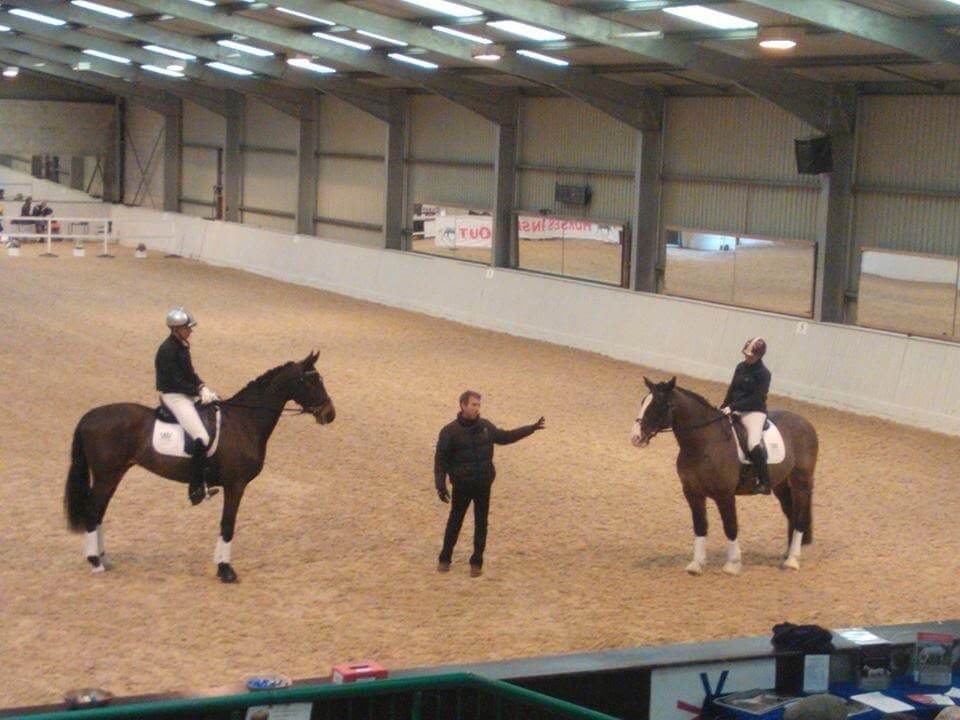The Annual Horses Inside Out conference this year had the title of “Training, Therapy and Performance” and whilst perhaps not as saddle related as last years, it was still an incredibly informative 2 days. You never stop learning in the equestrian world and we were introduced to some new ideas and research that has been completed. On a more personal note I came back enthused to use some of Chris Bartle’s training exercises on my own young horse.
This insightful annual conference is brought together by the anatomy and biomechanics author, artist and lecturer Gillian Higgins. Gillian explained how the muscles are grouped in chains and reminded us of the importance of a strong back in the horse in order to carry the weight of a rider and saddle. She also demonstrated some useful exercises to help achieve this: backing up in hand or reining back under saddle, the carrot exercise of encouraging the horse to stretch between his front legs both strengthen the back, particularly for horses with sacroiliac issues and kissing spine. Whilst spinning in hand and lateral works encourages a loose back. All highlighting that ongoing maintenance is long term prevention.
The speakers included:
Dr Kathryn Nankervis from Hartpury College, who gave a fascinating insight into “Exercise for the purpose of Rehabilitation” Horses with back pain are often linked as we know to hind limb lameness and the programme focuses on a developing their flexion and not extension, so straight line work is encourage. A key take home message was that so many horses encounter injury because they are not sufficiently prepared and fit for the job they are being asked to do – so the old saying “prevention is better than cure”.
Dr Colin Roberts presented research from his PHD “Aspects of respiratory function during exercise in the TB”. The resting heart rate for the horse is 25-45 bpm and this can increase up to 10 fold during strenuous exercise. Whilst not saddle related this was very interesting to learn that when endoscoped it was found that a very high percentage of Thoroughbreds (40-75% although probably occurs in all racehorses in fast work) do ‘bleed’ from stress/pressure in the lungs and not in the upper airway as previously believed. Signs are not apparent until the severity increases and blood is seen from the nostrils. However a nosebleed in a stabled/resting horse should be viewed differently and veterinary advice sought. Unlike muscles, the lung does not respond to training it was shown that fitness reaches a peak where it starts to plateau out considerably. So we are guilty sometimes of asking too much of our horses and over training which in itself can be the cause of injuries. So again a take home message along similar lines that the correct management of your horse helps prevent future issues.
Olympian Chris Bartle gave a very fun and inspiring demo on Polework Training for Improved Performance with the young horse. The use of cavaletti in different gaits to improve strength and rhythm was inspiring.


Lee Clark presented Kinesio Taping for Horses and Riders, a therapy were you can visually see instant results. Although this is not new I am sure we are going to see more of this in use in the equine field in the future.

Adam Kemp closed the conference with 2 very entertaining demonstrations on Training Related Performance where it was wonderful to see the development of young dressage horses progressing through to Grand Prix level.

There were many saddle fitters, trainers and therapists from around the world at the conference, which was a great opportunity to speak with other equine professionals from all spheres and continue to develop the ongoing knowledge of saddle fitting.
If you wish to view more of Gillian’s work visit www.horsesinsideout.com or view a great video on this link http://youtu.be/2Bpv_26nqA0


